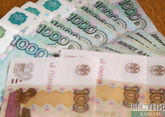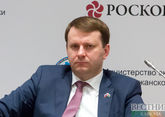Next year, the Russian economy is expected to face problems associated with a lending cycle phase change - this conclusion follows from the 2019-2024 macro forecast published by the Russian Economic Development Ministry.
Russia's Economic Development Minister Maxim Oreshkin said that the retail lending situation in Russia has become a 'social problem' with the debt to income ratio at 43.9% in the segment of cash loans in January–March, as calculated by the central bank, and 15% of borrowers had a more than 70% rate.
He said that the ministry has lowered the estimate for the growth of households’ real disposable income in 2019 to 0.1% from 1%.
"The 2019 forecast for the social sphere was somewhat lowered as compared with the scenario conditions. Taking into account the real figures, the real disposable income growth rate forecast was revised to 0.1%, after 1% forecasted earlier," the Prime news agency cited Oreshkin as saying.
The inflation forecast for 2019 was lowered to 3.8% from 4.3%, and was set at 3% for 2020 and at 4% for 2021–2024.
The poverty level is seen at 12.5% in 2019 and at 6.6% in 2024. The unemployment estimate was decreased to 4.6% from 4.7% in 2019, and set at 4.3% in 2024.
Retail sales rise is expected at 1.3% in 2019 after a 1.6% growth forecast, the increase is seen at 0.6% in 2020 against an earlier estimated 2.1%.
The 2020 real disposable income growth estimate is 1.5%, 2021 one – 2.2%, 2022 – 2.3%, 2023 – 2.3%, 2024 – 2.4%.
Oreshkin said that the ministry retained the gross domestic product (GDP) rise forecast for 2019 at 1.3%. "In the second half of the year, recovery of economic activity is expected taking into account a gradual easing of the monetary policy and a rise of budget spending growth. The GDP will amount to 1.3% in 2019, like expected before," he said.
Annual economic growth in July–December is expected at 1.5–2.0%.
The ministry lowered the 2020 GDP forecast to 1.7% from 2.0% and retained the forecast for 2021 at 3.1% and for 2022 at 3.2%.
The ministry lowered the investment growth forecast for 2019 to 2.0% from 3.1% and for 2020 to 5% from 7%. Estimates for 2021 were raised to 6.5% from 6.3% and for 2022 retained at 5.8%.
"Due to the weakness of consumer demand and the weakness of the global economy, investment will become the key growth driver of the economy, it will grow by 5% in 2020 after 2% in 2019," Oreshkin said. Red tape for businessmen will decline, and regional investment will be supported on the federal level, the lending structure will change and new sources of financing of investment will form. Besides, business trust in the law enforcement authorities will recover, he said.
The industrial production growth forecast was retained at 2.3% in 2019, lowered to 2.4% from 2.6% for 2020, to 2.7% from 2.9% for 2021, retained at 2.9% in 2022.
The ministry reduced the forecast for the average Urals price in 2019 to $62.2 from 63.4, and for 2020 to $57 from $59.7, for 2021 to $56 from $57.9 and, 2022 to $55 from $56.3, for 2023 to $54 from $55 and for 2024 to $53 from $53.5.
The average ruble rate forecast was cut to 65.4 for $1 from 65.1 in 2019, to 65.7 from 64.9 in 2020 and to 66.1 from 65.4 for 2021. The forecast for 2022 was changed to 66.5 from 66.2, for 2023 to 66.9 from 67, for 2024 to 67.4 from 68.6.










